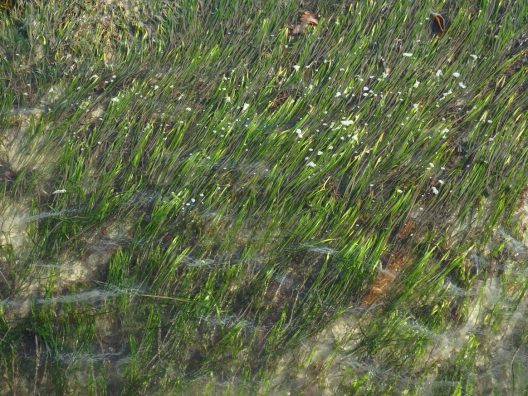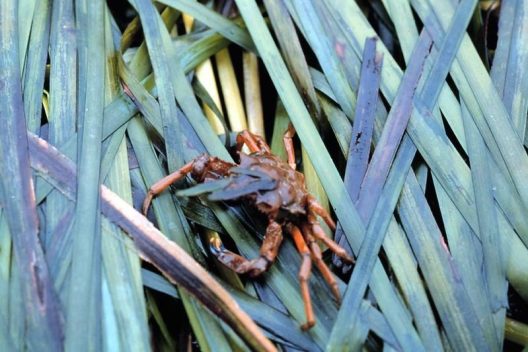A Timeline of Eelgrass Restoration
The dynamic coastline of Puget Sound is known for scenic coastal views and abundant wildlife with an impressive diversity of seabirds, fish, and invertebrates. A foundational component of Puget Sound ecosystems is the marine perennial plant commonly known as eelgrass. Eelgrass forms highly productive habitats that nurse much of the wildlife appreciated around the greater Puget Sound. Eelgrass is sensitive to environmental change and as environmental changes become an ever-increasing concern, the need to maintain eelgrass beds increases as well. The conservation and restoration of eelgrass has been ongoing for decades in Washington State. Providing an overview of the timeline and strategies involved with eelgrass restoration gives a glimpse into the efforts that will be required to rebuild eelgrass habitat in Puget Sound.
Eelgrass is a submerged aquatic flowering plant that grows in soft sediment and sandy seafloor environments. It can be found throughout the bays, estuaries, and tidelands of much of the Northern Hemisphere. The species Zostera marina is the most common species of eelgrass in Puget Sound, where it occurs as expansive meadows in bays, or as linear fringe beds that follow the shoreline. The linear fringe eelgrass habitats are the most common around the Sound, and can act as corridors for migratory salmon.
Eelgrass provides important physical benefits to shoreline through structural support, securing sediments and reducing wave impacts. In addition, eelgrass beds sequester carbon and improve overall water quality. These highly productive environments provide essential ecosystem functions that support many recreationally and commercially important species. Salmon, herring, and many shellfish species utilize eelgrass for food, cover, and protection. The ecological functions of eelgrass beds are numerous and promote the overall vitality of Puget Sound.
Eelgrasses are highly sensitive to anthropogenic environmental changes and physical disturbances, including damage from vessel anchoring, shoreline modifications, and water quality degradation. Stressors to eelgrass vary in magnitude across locations within the Sound, and multiple threats can occur simultaneously. The individual effects of anthropogenic stressors on eelgrass beds are difficult to quantify, and specific stressor-response pathways of eelgrass loss are uncertain. The highly sensitive nature of eelgrass to environmental changes has led to its classification as a vital sign indicator of overall Puget Sound ecosystem health.
Preserving and restoring eelgrass beds in the Puget Sound has been an ongoing conservation goal since 2000, led by the submerged vegetation monitoring program conducted by the Washington Department of Natural Resources. Incidence of global eelgrass declines has led to widespread recognition of the importance of eelgrass and the need to restore eelgrass habitats. A 2020 goal to extend eelgrass coverage by 20% was adopted by the Puget Sound Partnership in 2011, leading to the development of the Puget Sound Action Agenda in 2015. This agenda set a recovery strategy for five overarching goals, with the third overarching goal being to restore and conserve degraded or declining eelgrass beds.

The 20% by 2020 target has not yet been met, but ongoing survey efforts have shown existing eelgrass populations around Puget Sound to be stable (though still lower than historical levels). Site-specific declines in eelgrass beds were reported in the 2018-2020 Puget Sound Seagrass Monitoring Report, which found declines in the San Juan Islands and Cypress Island. Such declines have highlighted the comprehensive efforts needed to conserve and restore eelgrass beds in Puget Sound. The Puget Sound eelgrass recovery strategy proposes multiple avenues to recovery, including the reduction of stressors, restoration of tidal wetlands, and transplantation of eelgrass between sites.
Transplantation is the strategic relocation of eelgrass shoots from one location to another to promote new and expansive plant growth. Eelgrass transplantation is a multi-step process that begins with the development of a model or simulation to predict site suitability of candidate sites for eelgrass growth. Once sites have been selected, field surveys are carried out and test transplantations are made to measure growth. Eelgrass shoot donor sites are selected based on eelgrass abundance and the ability of the harvest site to sustain optimal growth following the removal of shoots. Harvested shoots can be attached to a substrate—rebar, staple or washer—that is then placed into the sediment at the restoration site. The aim of shoot transplantation is that the planted shoots will initiate the recolonization of eelgrass through vegetative growth. Regular monitoring is carried out following transplantation to assess performance and identify barriers to success. Transplantation projects have been carried out by the Nearshore Habitat Program at the Washington State Department of Natural Resources since 2012. Most eelgrass transplantation efforts have been unsuccessful, factors cited as barriers to transplantation success vary across sites but are often physical or biological. One reported successful transplantation having occurred in a collaborative project between Pacific Northwest Laboratory with the Lower Elwha Klallam Tribe.
The reduction of stressors to eelgrass populations is another strategy to help restore and conserve eelgrass beds. The regional loss of eelgrass in the Sound is likely caused by the stressor-response pathways that impact eelgrass growth and expansion. The ability of eelgrass beds to naturally recover will be limited if stressors are not reduced. Proposed stressor reductions include the modification and removal of overwater structures, reducing damage caused by vessel anchoring and mooring in eelgrass habitats, reducing nutrient loading, improving overall marine water quality, and reducing impact due to shoreline armoring. The restoration of nearshore ecosystems associated with eelgrass beds has additionally been identified to be an important aspect of eelgrass recovery and conservation. Restoring tideland habitats and their ecosystem functions is likely to promote eelgrass growth and expansion while connecting fragmented eelgrass beds.

The regional declines in eelgrass beds at survey sites within the state have led to increased efforts to protect eelgrass and continue to restore losses. In March of 2022 the Washington State Legislature passed Senate Bill 5619. This law calls for the Department of Natural Resources to create a statewide kelp forest and eelgrass meadow health and conservation plan, with the goal to conserve and restore at least 10,000 acres of kelp and eelgrass meadow habitat by 2040. This plan will build on the Puget Sound Eelgrass Recovery Strategy and advance the objectives put forward in 2015.
The 2020 goal of a 20% increase in eelgrass cover from baseline measurements that began in 2000 has not been met but the overall outlook for eelgrass in Puget Sound is positive. However, threats to restoration are still present through the continued prevalence of eelgrass stressors such as climate change, disease and population growth. The Washington State Department of Natural Resources estimates there are 23,000 hectares of eelgrass in the greater Puget Sound and Sound wide measurements show population stability. The conservation and restoration of eelgrass throughout Puget Sound should remain a priority.